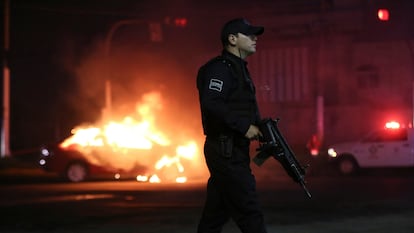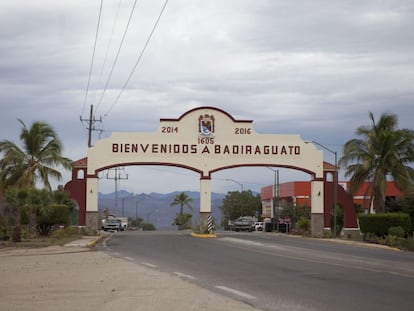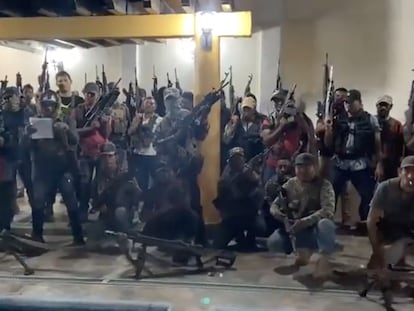‘El Mencho’: Chasing the most powerful drug lord in Mexico
Nemesio Oseguera Cervantes is the leader of the brutal Jalisco New Generation Cartel. Despite being the most wanted criminal in North America, with millions of dollars in rewards hanging over his head, both the Mexican and US governments have failed to track him down

The last time a relative of “El Mencho” was arrested, two Mexican marines were kidnapped in an act of revenge. Subsequently, a military siege was unleashed, with tanks and helicopters turning one of Guadalajara’s most exclusive neighborhoods into a war zone.
On Tuesday, December 20, after the arrest of the kingpin’s brother, Antonio Oseguera (aka Tony Montana), the authorities in Jalisco, Colima and Michoacán were on high alert, with soldiers and police assigned to guard almost every corner across the states. In the end, the only retaliatory act of violence committed by members of the Jalisco New Generation Cartel was a car being torched. But the extreme show of force by the security services was proof of how much the conflict between the government and Mexico’s most powerful mafia has escalated.
El Mencho – the alias of Nemesio Oseguera Cervantes – is the head of the Jalisco New Generation Cartel. He is the number one target for both the American and Mexican authorities. The US Justice Department is offering up to $10 million for leads that could result in the capture of the most-wanted criminal in North America. Yet despite all the effort devoted to catching one man, the hunt for El Mencho has turned into a vengeful game of chess – an endless succession of attacks and counter-attacks.
In practically all corners of the country, the mafia has a presence – even in Aguascalientes, one of the smallest of Mexico’s 32 states
Back in 2015 – when he was beginning to establish himself as the heir to El Chapo in the realm of organized crime – one of El Mencho’s men was killed by the Mexican Army. In response, a military convoy was ambushed, with 15 agents being murdered. Then, the arrest of several of the hitmen who were involved was followed by blockades throughout Jalisco and a military helicopter being shot down by a bazooka.
Three years later, when El Mencho’s wife was arrested for the first time – charged with leading the cartel’s financial apparatus – this was read as a governmental response to the attempted assassination of a former prosecutor. Her second arrest in 2021 resulted in the infamous case of two marines being abducted.
The recent arrest of El Mencho’s brother, meanwhile, has been interpreted by several analysts as retaliation for the abduction of a colonel at the hands of the cartel. However, security expert Alejandro Hope does not believe that the arrest of Antonio Oseguera is necessarily related to the kidnapping of Colonel José Isidro Grimaldo, who was “disappeared” by cartel members on December 10. He thinks that the security forces were preparing for the operation to capture El Mencho’s brother long before the abduction.
“This may be a coincidence… perhaps the kidnapping of the soldier may have injected some urgency into the matter.”
Hope also rules out the possibility that the arrest of the drug lord’s brother may be a means of getting New Generation to negotiate for the release of the colonel. It’s still unclear what exact role Tony Montana had in the structure of the criminal organization. “This won’t change the [cartel’s] calculations,” he notes.
The recent leak of millions of emails from the Mexican military leadership – known as the Guacamaya Leaks – demonstrated the intense intelligence work of the Ministry of National Defense in monitoring Jalisco New Generation’s tentacles. In practically all corners of the country, the mafia has a presence – even in Aguascalientes, one of the smallest of Mexico’s 32 states. But most of the secret operations have not resulted in great success. For instance, when the Army conducted a failed raid (based on faulty intelligence) in an attempt to arrest a major kingpin, violent retaliation swept across the states of Jalisco and Guanajuato.
“How much intelligence does the Army have?” asks Guillermo Valdés, who led Mexico’s National Intelligence Center during the presidential administration of Felipe Calderón (2006-2012).
“From what we saw in the documents from the Guacamaya Leaks, they have a lot of intelligence… but they don’t use it. Sporadic arrests won’t amount to much.”
Despite the consolidation of the militarized strategy imposed by President Andrés Manuel López Obrador – with the creation of the National Guard and the massive deployment of soldiers in the streets – the government appears to be more focused on containment. There isn’t much interest in attacking organized crime. Nevertheless, violence in Mexico has hardly declined during the past four years of the López Obrador administration.
Carlos Flores – a researcher and security specialist who has studied the Jalisco New Generation Cartel in depth – points out that the government’s strategy “lacks adequate synergy” with other bodies. There is little cooperation with institutions such as the Financial Intelligence Unit or the Prosecutor’s Office, in order to convict gangs for organized crime.
“They should focus on networks and not individuals,” he explains. The difference that Flores detects between López Obrador’s attitude towards drug trafficking in relation to previous administrations is mainly rhetorical… perhaps a little less offensive. The approach hasn’t changed, he insists, because “there remains a tendency to give continuity to the ‘kingpin’ strategy,” he sighs, referring to the practice of devoting enormous resources to pursuing criminal leaders.
The strategy of beheading the cartels by arresting their bosses was especially relevant during the government of Enrique Peña Nieto (2012-2018). This paved the way for the emergence of El Mencho and his cartel, given the displacement of other top dogs. For Guillermo Valdés – who led the intelligence service during the militarized escalation of the war on drugs, before Peña Nieto took office – “there is no general strategy to dismantle criminal organizations... only the [search for] big bosses.”
Now an analyst, Valdés references the time he spent helping to dismantle “The Zs” – one of Mexico’s largest and most violent criminal syndicates, now significantly diminished.
“First, we focused on the operative cells… the hitmen, the regional bosses, the accountants, the financial operators. We were undermining the organization from below to weaken it. After that, we were able to catch the leaders.”
Valdés does recognize, however, that times have changed. “It’s true that [Jalisco New Generation] is more aggressive against the state.”
Of all the attacks on police, military, politicians and judges perpetrated by El Mencho’s mafia, surely the one with the greatest impact was the assassination attempt two years ago on Mexico City’s police chief, Omar Harfuch. More than 20 hitmen fired 414 bullets at him with assault rifles in the middle of an ambush in one of the most exclusive areas of the capital. Miraculously, he recovered from his injuries and survived. Two of his bodyguards and a female passerby were killed in the attack.
Sign up for our weekly newsletter to get more English-language news coverage from EL PAÍS USA Edition
Tu suscripción se está usando en otro dispositivo
¿Quieres añadir otro usuario a tu suscripción?
Si continúas leyendo en este dispositivo, no se podrá leer en el otro.
FlechaTu suscripción se está usando en otro dispositivo y solo puedes acceder a EL PAÍS desde un dispositivo a la vez.
Si quieres compartir tu cuenta, cambia tu suscripción a la modalidad Premium, así podrás añadir otro usuario. Cada uno accederá con su propia cuenta de email, lo que os permitirá personalizar vuestra experiencia en EL PAÍS.
¿Tienes una suscripción de empresa? Accede aquí para contratar más cuentas.
En el caso de no saber quién está usando tu cuenta, te recomendamos cambiar tu contraseña aquí.
Si decides continuar compartiendo tu cuenta, este mensaje se mostrará en tu dispositivo y en el de la otra persona que está usando tu cuenta de forma indefinida, afectando a tu experiencia de lectura. Puedes consultar aquí los términos y condiciones de la suscripción digital.
More information
Archived In
Últimas noticias
Most viewed
- Alain Aspect, Nobel laureate in physics: ‘Einstein was so smart that he would have had to recognize quantum entanglement’
- Mexico’s missing people crisis casts a shadow over World Cup venue
- Why oil has been at the center of Venezuela-US conflicts for decades
- Trump clarifies who is ultimately in charge in Venezuela: ‘Me’
- Mexico seeks to shore up its defenses following US incursion in Venezuela










































